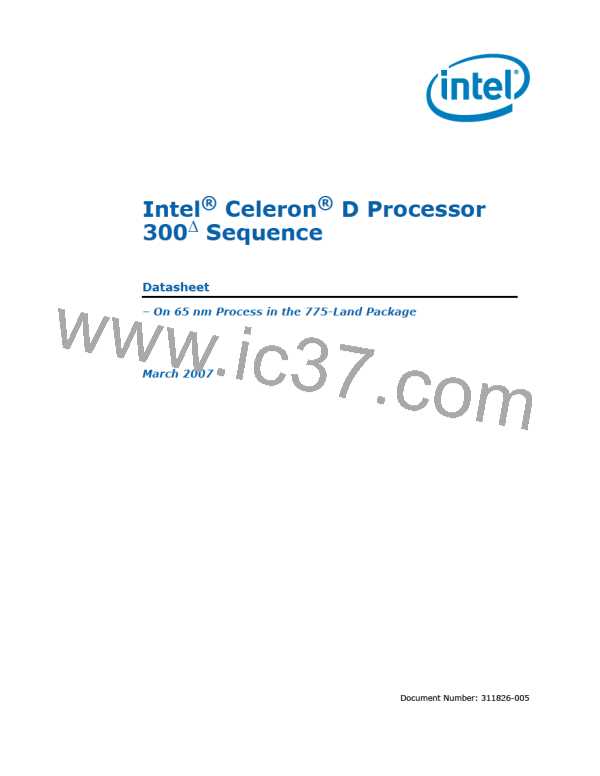Land Listing and Signal Descriptions
Table 25.
Signal Description (Sheet 1 of 9)
Name
Type
Description
FERR#/PBE# (floating point error/pending break event) is a
multiplexed signal and its meaning is qualified by STPCLK#. When
STPCLK# is not asserted, FERR#/PBE# indicates a floating-point
error and will be asserted when the processor detects an unmasked
floating-point error. When STPCLK# is not asserted, FERR#/PBE# is
similar to the ERROR# signal on the Intel 387 coprocessor, and is
included for compatibility with systems using MS-DOS*-type
floating-point error reporting. When STPCLK# is asserted, an
assertion of FERR#/PBE# indicates that the processor has a pending
break event waiting for service. The assertion of FERR#/PBE#
indicates that the processor should be returned to the Normal state.
For additional information on the pending break event functionality,
including the identification of support of the feature and enable/
disable information, refer to volume 3 of the Intel Architecture
Software Developer's Manual and the Intel Processor Identification
and the CPUID Instruction application note.
FERR#/PBE#
Output
GTLREF[1:0] determine the signal reference level for GTL+ input
GTLREF[1:0]
Input signals. GTLREF is used by the GTL+ receivers to determine if a
signal is a logical 0 or logical 1.
Input/
HIT# (Snoop Hit) and HITM# (Hit Modified) convey transaction
Output
HIT#
snoop operation results. Any FSB agent may assert both HIT# and
HITM# together to indicate that it requires a snoop stall, which can
HITM#
Input/
be continued by reasserting HIT# and HITM# together.
Output
IERR# (Internal Error) is asserted by a processor as the result of an
internal error. Assertion of IERR# is usually accompanied by a
SHUTDOWN transaction on the processor FSB. This transaction may
optionally be converted to an external error signal (e.g., NMI) by
IERR#
Output
system core logic. The processor will keep IERR# asserted until the
assertion of RESET#.
This signal does not have on-die termination. Refer to Section 2.5.2
for termination requirements.
IGNNE# (Ignore Numeric Error) is asserted to the processor to
ignore a numeric error and continue to execute noncontrol floating-
point instructions. If IGNNE# is de-asserted, the processor
generates an exception on a noncontrol floating-point instruction if a
previous floating-point instruction caused an error. IGNNE# has no
effect when the NE bit in control register 0 (CR0) is set.
IGNNE#
IMPSEL
Input
IGNNE# is an asynchronous signal. However, to ensure recognition
of this signal following an Input/Output write instruction, it must be
valid along with the TRDY# assertion of the corresponding Input/
Output Write bus transaction.
IMPSEL input will determine whether the processor uses a 50 Ω or
60 Ω buffer. This pin/land must be tied to GND on 50 Ω platforms
and left as NC on 60 Ω platforms. This input has a weak internal
Input
pull-up to VTT.
68
Datasheet

 INTEL [ INTEL ]
INTEL [ INTEL ]